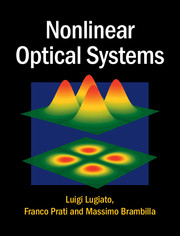Book contents
- Frontmatter
- Dedication
- Contents
- Preface
- Part I Models, propagation, stationary phenomena
- Part II Dynamical Phenomena, Instabilities, Chaos
- Part III Transverse optical patterns
- 26 Gaussian beams and modes of cavities with spherical mirrors
- 27 General features about optical pattern formation in planar cavities
- 28 The Lugiato-Lefever model
- 29 Spatial patterns in cavities with spherical mirrors
- 30 Cavity solitons
- Appendix A The Routh–Hurwitz stability criterion
- Appendix B Calculation of the oscillatory instability boundary
- Appendix C Coefficients of the characteristic equation (20.20)
- Appendix D Derivation of equations (20.27) and (20.28)
- Appendix E Coefficients of equations (20.60) and (20.61)
- Appendix F The exact boundary of the Risken–Nummedal–Graham–Haken instability
- Appendix G Nonlinear analysis of the roll solution
- References
- Index
29 - Spatial patterns in cavities with spherical mirrors
from Part III - Transverse optical patterns
Published online by Cambridge University Press: 05 March 2015
- Frontmatter
- Dedication
- Contents
- Preface
- Part I Models, propagation, stationary phenomena
- Part II Dynamical Phenomena, Instabilities, Chaos
- Part III Transverse optical patterns
- 26 Gaussian beams and modes of cavities with spherical mirrors
- 27 General features about optical pattern formation in planar cavities
- 28 The Lugiato-Lefever model
- 29 Spatial patterns in cavities with spherical mirrors
- 30 Cavity solitons
- Appendix A The Routh–Hurwitz stability criterion
- Appendix B Calculation of the oscillatory instability boundary
- Appendix C Coefficients of the characteristic equation (20.20)
- Appendix D Derivation of equations (20.27) and (20.28)
- Appendix E Coefficients of equations (20.60) and (20.61)
- Appendix F The exact boundary of the Risken–Nummedal–Graham–Haken instability
- Appendix G Nonlinear analysis of the roll solution
- References
- Index
Summary
In Chapters 27 and 28 we discussed the topic of optical spatial pattern formation in planar cavities. In this chapter, instead, we consider the case of ring cavities with spherical mirrors, on the basis of the discussion of transverse modes in Chapter 26.
In the first section we derive, first of all, a set of modal equations to be coupled with the atomic equations, with a configuration similar to that of the modal equations of Chapter 12, with the difference that now transverse modes are included in addition to longitudinal modes. This provides an extremely complex context, and therefore in the following we focus on the case of quasi-planar cavities, in which it is possible, by introducing the low-transmission and single-longitudinal-mode approximations, to derive a single-longitudinal-mode model that represents, in the framework of cavities with spherical mirrors, the counterpart of the single-longitudinal-mode model for planar cavities discussed in Chapter 27.
In Section 29.2 we consider the simplest configuration, in which only the fundamental Gaussian transverse mode is assumed to have negligible losses, so that it is possible to consider a single-mode model that includes only the Gaussian mode. This is precisely the model considered in Section 24.3.1 for the comparison with experimental data concerning the single-mode instability of optical bistability. We calculate the stationary curve, and in the laser case we demonstrate the validity of the mode-pulling formula also in this configuration.
In the following section we consider, instead, the general case in which several transverse modes of a laser are involved and demonstrate that the modal equations admit multimodal stationary intensity states, a configuration that is not possible in the case of longitudinal modes, at least in the low-transmission approximation. In this phenomenon, which we call cooperative frequency locking, the modes agree a common oscillation frequency that is given by the average of the (mode-pulled) modal frequencies, with weights given by the modal intensities. Numerical and experimental evidence of cooperative frequency locking is provided.
- Type
- Chapter
- Information
- Nonlinear Optical Systems , pp. 378 - 392Publisher: Cambridge University PressPrint publication year: 2015

